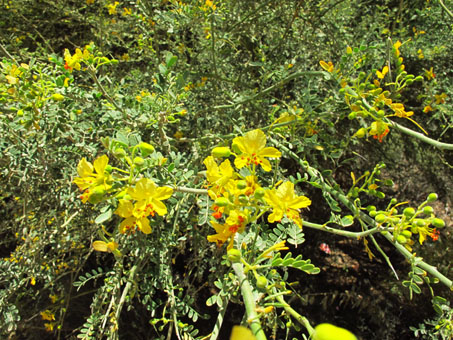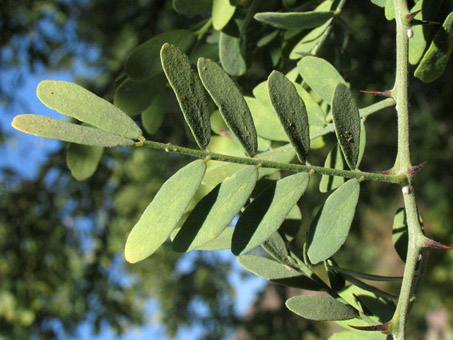THE UC HIVE JUN 2024
Fabulous Fabs: Parkinsonia and Olneya
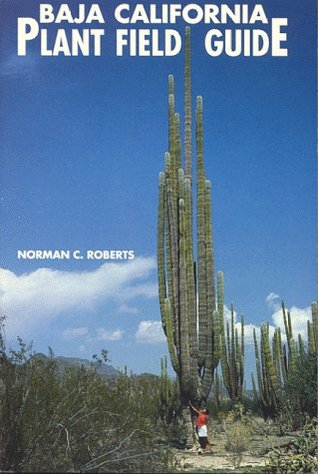 Back in the mid 1990s, when we bought our first Baja California Plant Field Guide, and about 10 years before I turned into an obsessed plant nut, I remember being totally overwhelmed by all of the similar-looking species of leguminous plants. I was soon determined to learn to recognize as many of the common shrubs and trees as possible that I came across.
Back in the mid 1990s, when we bought our first Baja California Plant Field Guide, and about 10 years before I turned into an obsessed plant nut, I remember being totally overwhelmed by all of the similar-looking species of leguminous plants. I was soon determined to learn to recognize as many of the common shrubs and trees as possible that I came across.
It is a long term process, far from complete, but I think I’ve got a handle on quite a few of those that I have come across on our travels throughout the peninsula over the years.
Getting to know these leguminous plants has required seeing them and studying them in the field and/or under the microscope in different phenological states so that I could put an image together in my head of the key ID characteristics for each as described by botanists in botanical treatments, dichotomous keys or guidebooks.
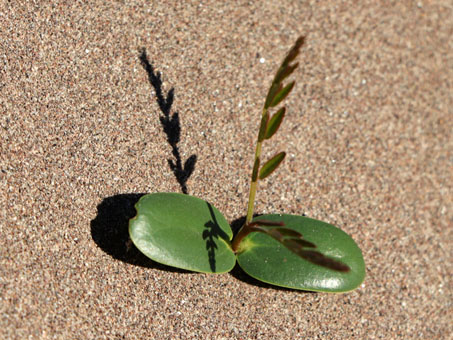 I can and will place some of the protracted pain and suffering of learning to ID a number of these plants on the guide books and botanical works that could be so frustrating because they were vague, contradictory, incomplete, or completely wrong.
I can and will place some of the protracted pain and suffering of learning to ID a number of these plants on the guide books and botanical works that could be so frustrating because they were vague, contradictory, incomplete, or completely wrong.
Vague or contradictory in the sense that descriptions could be open to interpretation (e.g. something is broadly ovate or just ovate; a leaf is soon glabrate) or there could be overlap in particular key characters (eg. sp.1 has 2-6 leaflets, sp.2 has 4-8; sp.1 inflorescence is capitate while sp.2 is capitate to spicate).
Incomplete meaning that if a key character was not observable there might not be enough enough other detail in the description to help.
And I remember my first taste of botanical competence as a budding field botanist years ago when I realized that the description in my field guide didn’t match the photo and that a subsequent guidebook I just bought had used that same rrect photo as the basis of an illustration.
And lastly, my first five years of botanical learning were pre-internet. OMG, how was it even possible?
Hopefully my work below can eliminate at least some of the pain and suffering of the learning curve for you, although there is nothing like a little hands-on experience, failure and success for solidifying learning.
This month, I’m just going to tackle the genus Parkinsonia, the Palo Verde. There are four species and three recognized hybrids on the peninsula but I will only present five of these eight here.
And I’ll throw in a bonus fabulous fab, Desert Ironwood (Olneya tesota, a monotypic genus), mainly because all six of these taxa are now in all of their magnificent glory here around Mulegé.
Parkinsonia
Interestingly, while the English common name for this genus is the Spanish Palo Verde (literally green stick or branch), at least in the Gulf of California region, including the Baja California peninsula, only one species actually bears that common name.
Common features shared by all of our (i.e. peninsular) taxa of Parkinsonia include:
- green, photosynthetic bark
- spines (axillary or nodal) or spinose branches
- small, pinnate or bipinnate leaves
- flowers in short, axillary racemes
- yellow flowers with four ±similar petals & a banner of a different color or with orange spots
Parkinsonia aculeata — Mexican Palo Verde, Junco
Mexican Palo Verde is typically a multi-stemmed shrub or slender tree that ranges anywhere from 1-12 m H. At least in our area here in the Gulf coast desert, it is no more than half that height. The tree's overall appearance is that of an open, airy, insubstantial tree with blue-green bark to the base of the trunk, slightly drooping, zig-zag branches, and long wispy leaves. One to three nodal spines (located below the leaf bases) are present both along the trunk and branches. It can often be found growing along the highway and in washes and arroyos in the BC and BCS deserts. But it can also be found growing in riparian areas, such as along the Mulegé river and estuary as well as in the San José de Magdalena arroyo alongside all the pools.
Range: this species is possibly native to the peninsula but it is difficult to determine with any certainty because it is commonly planted as an ornamental (Rebman et al. 2016). It is thought to be native to Sonora, Sinaloa, Arizona and Texas and introduced across Mexico, the southern US, and South and Central America.
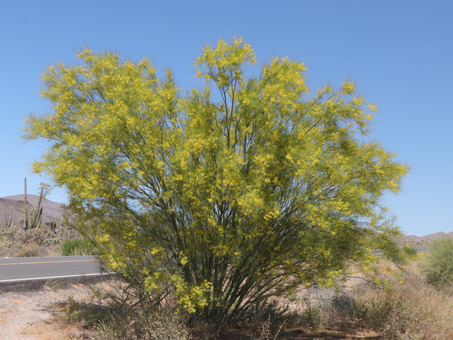
This particular shrubby Junco is growing in the Central Desert not far south of Laguna Chapala. Note the wispy, see-through nature and drooping leaves.
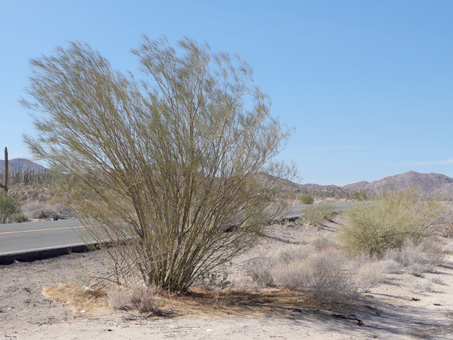
This is the same shrub as at left. This image was taken in Jan. 2022 while the previous one is from May 2020. Zoom in to better see the multiple stems, wispy leaf rachises & branches of this 3-4 m tall shrub.
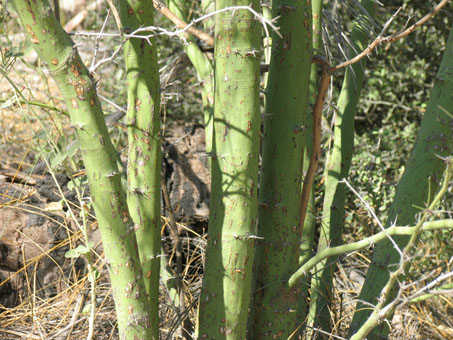
Multiple stems of another shrubby individiual. The small, but sharp nodal spines are visible on both trunk and branches.
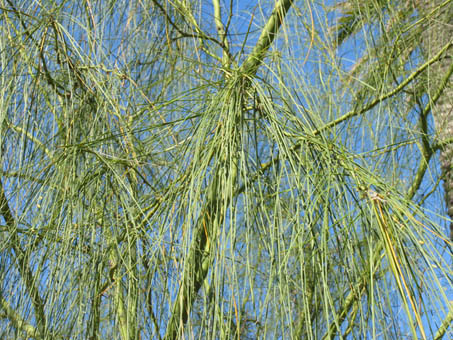
To me, the drooping leaves are reminiscent of those of a Weeping Willow. Each leaf has a flat, persistent, ribbon-like rachis to 60 cm L.
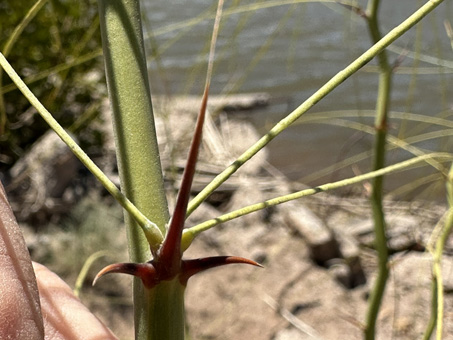
There are 2-4 leaves per node; three rachises can be seen here subtended by three very sharp nodal spines. Note the zig-zag of branches behind.
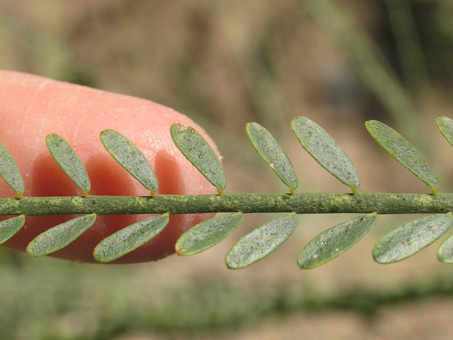
Each leaf has 30-60 ovate, ephemeral leaflets that are 3-5 mm L x 1-1.5 mm wide. Per Wiggins (1980), the rachises are the principal photosynthetic tissue. By flowering, the leaflets have usually fallen.
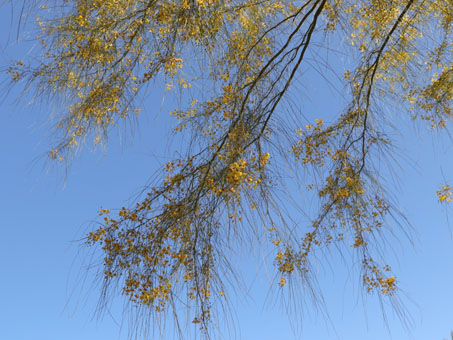
Looking up into the canopy of a tree, showing the wispy persistent leaf rachises. The zig-zag stems are visible here and in the next image.
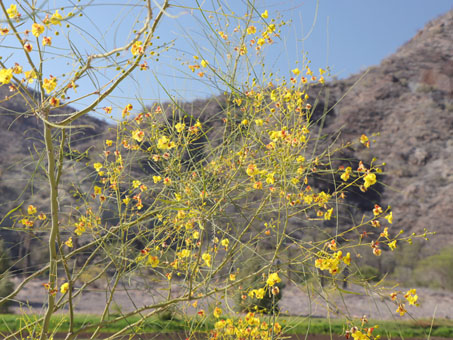
A very small tree (c. 1.5 m H) along the Mulegé river, showing the open, airiness of the plant. Flowers almost seem to float in the air.

Flowers are c. 2 cm D. The five rounded, yellow petals are ±equal in size. The upper (banner) has orange spots near the claw and turns orange to deep maroon after pollination.
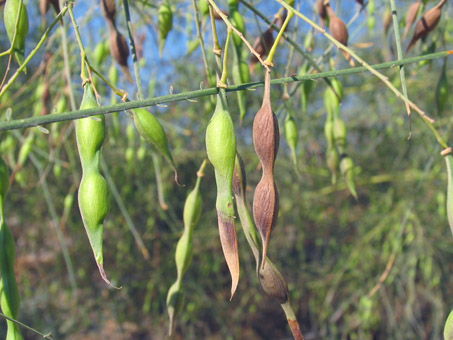
Fruit are moniliform (i.e. resembling a string of beads=. They are 4-12 cm L, and become tough and leathery. The oblong seeds are hard, smooth and shiny.
Parkinsonia florida — Blue Palo Verde, Palo Verde
In my mind, there is a strong relationship between Blue Palo Verde and pipe cleaners. I see pipe-cleaner trees. At a distance, the leafy, erect or spreading branches resemble those small pieces of wire with bristles all around the axis used for pipes and crafts.
Range: this common desert native occurs from the Sierra Guadalupe in BCS southward to the Cape along both sides of the peninsula. It also occurs on several islands off both coasts, Sinaloa and Sonora, Arizona and California.
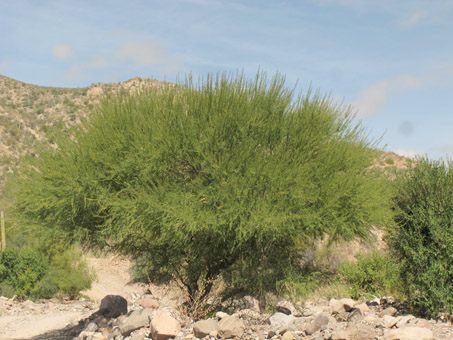
Trees of this species can reach 7-10 m H and have a well-developed trunk. Zoom in to see those pipe cleaner-like branches.
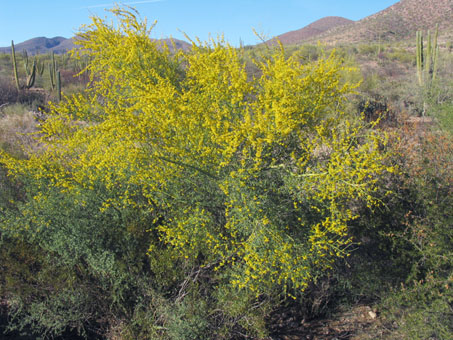
Some individuals, like this one, are shrubby. Most individuals are usually quite dense and like here, full of leaves even when blooming.
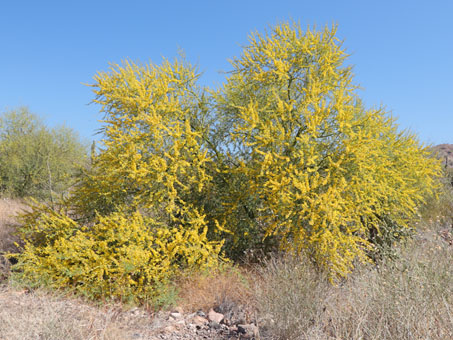
Even when blooming intensely, this species retains many of its leaves. Now the branches full of flowers look like yellow pipe cleaners.
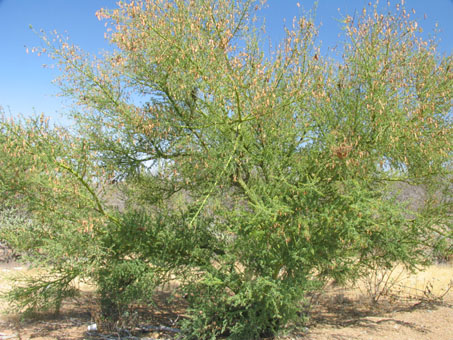
Another leafy individual with lots of fruit in the upper branches.
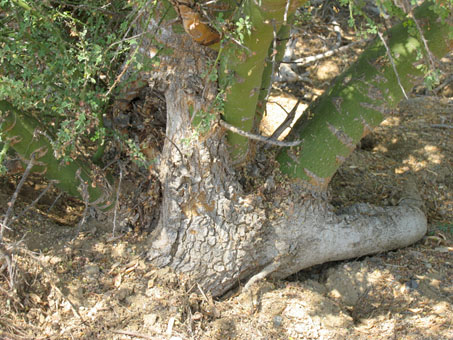
The bark is generally blue-green; however, the base of the trunk & older bark is typically gray. Like all Parkinsonias, the bark is photosynthetic.
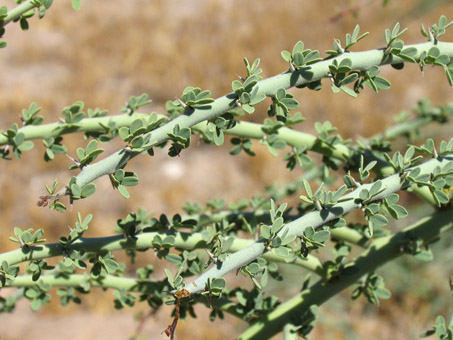
The branches & twigs are glabrous to pubescent (as here). There is one set of pinna, with a rachis <1 cm L bearing 2-6 obovate leaflets, each 4-8 mm L. Can you see the pipe cleaner resemblance?
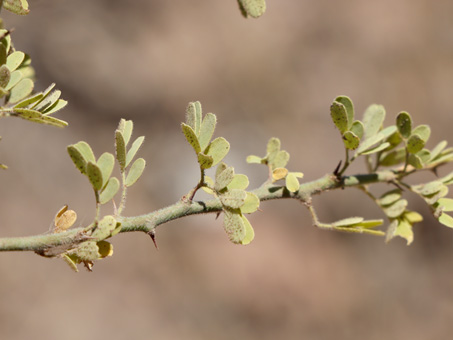
The leaf at center clearly shows the pair of pinnae, each with 3 pairs of obovate leaflets and a single, straight axillary spine (below the leaf).
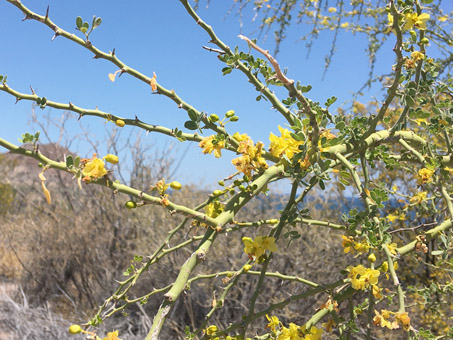
The stiff, zig-zagging branches are ascending to spreading, and in this individual the lower ones are arcuate. The tips can be stubby.
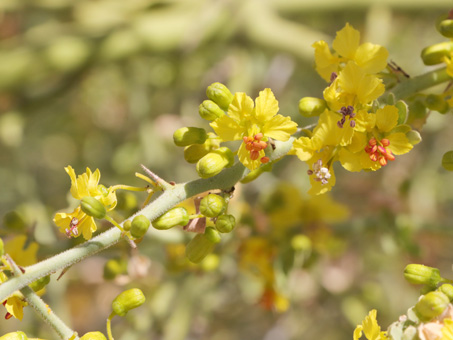
All five petals are clear yellow. The banner doesn't change color after pollination. Fls are 22-28 mm, the banner 12-17 mm.
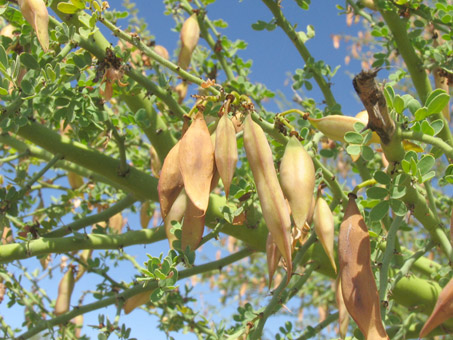
The 4-10 cm L pod is tan, ±flat and may or may not have a short, beak-like tip. The pod is not narrowed between seeds.
Parkinsonia microphylla — Little-leaf Palo Verde, Dipugo, Dipúa
This common native species is recognizable by its smooth, yellow-green bark and wispy, mostly ascending or spreading broom-like branches. Older bark, especially on the lower trunk, turns gray. It can be a shrub or small to large tree reaching to 9 m H. This species lacks nodal spines but has spinose tipped branchlets. In mature trees, these are not very stiff, but young plants will have stiff, intricately arranged branches with short, very pointy branchlets which protect it from browsing. Leaves are 2-pinnate with tiny leaflets.
Range: from around Mexicali to the northern Cape Region along the eastern side of the peninsula. Also occurs in the deserts of Sonora, Arizona and California.
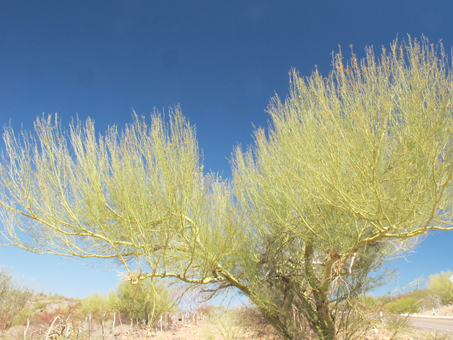
This tree is leafless and the yellow-green bark shows up clearly. Note the wispy, broom-like arrangement of the branchlets.
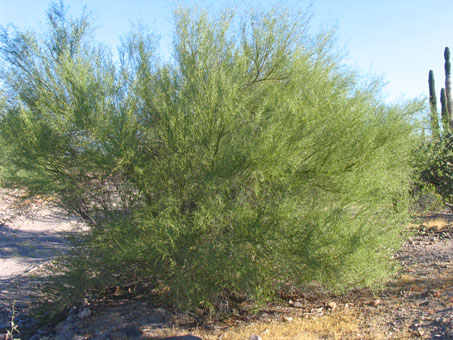
This individual is full of leaves, obscuring the paler green bark below. Leaves appear in the late summer or fall. They are drought-deciduous but will also begin to fall as the plant prepares to flower.
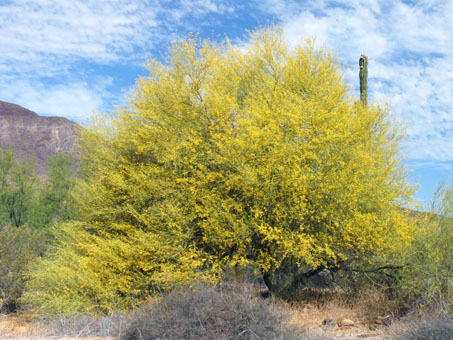
By the time it is flowering, there are very few leaves and what is visible are only the airy branches filled with varying densities of flowers.
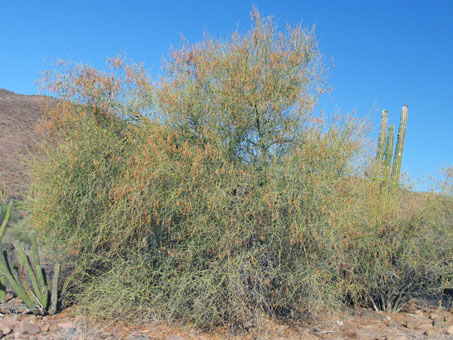
This individual is leafless and is now covered with maturing bean pods. The green is from the photosynthetic green bark of the branches.
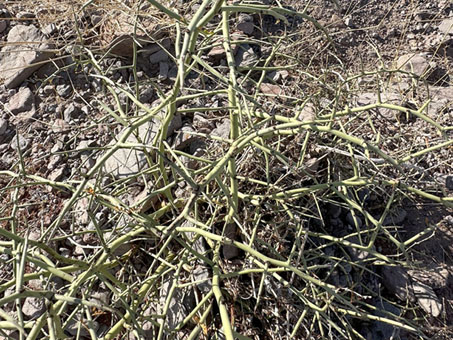
A young individual showing the intricate branching of the short, sharp spinose branchlets. At this stage, the branchlets are quite rigid.
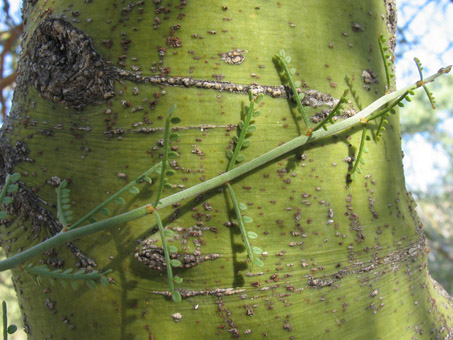
Closeup of the photosynthetic bark & leaves. The leaves are soon decidous, turning yellowish-orange before falling..
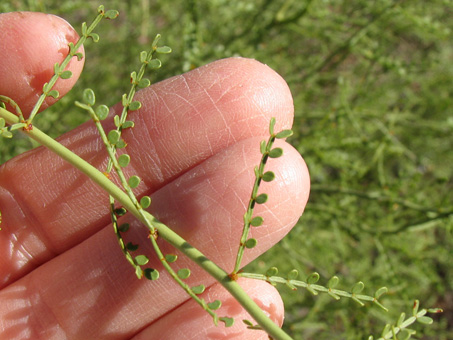
Leaves are glabrous & have one pair of sessile pinnae 1-5 cm L with 4-6 sets of ephemeral, broadly ovate to orbicular leaflets each 1-3.5 mm L.
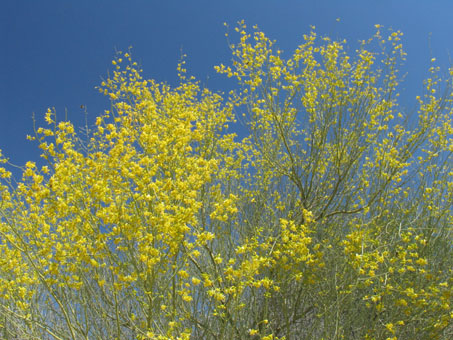
Flowers are in short racemes from the leaf axils and here are flowering profusely.
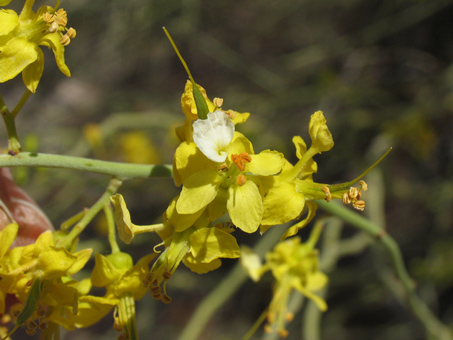
Flowers are 12-14 mm D with four ±equal yellow petals and a white banner ≤10 mm w that turns yellow after pollination.
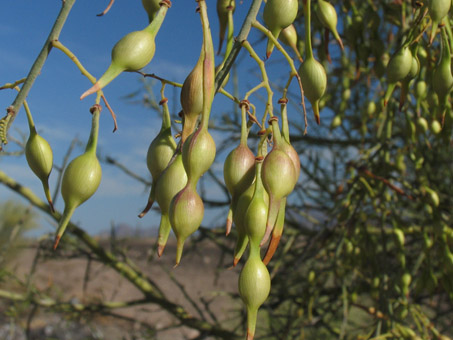
The mature pods are brown, 4-8 cm L, sparsely pubescent & moniliform with a long, flattened beak. Branches & pods are eaten by livestock.
Parkinsonia praecox — Palo Brea
This native tree is distinguished from other Parkinsonia taxa by its open, umbrella-like, see-through architecture that is quite striking when it is bare or full of blossoms. It may reach 4-5 m tall with branches that are spreading to ascending and often contorted. The smooth bark is lime green, usually from the ground up. Leaves have 1-2 pinnae with 4-8 pairs of elliptic to oblong leaflets arranged sparsely or densely around the branch.
Range: BCS native; from Sierra de San Francisco southward to the Cape region. It is more common southward from Loreto (BCS). It is rare along the immediate coast in the Mulegé area, but starts to show up above about 200 m elevation in the mountains to the east and southward. It is also present on some Gulf islands and widespread on mainland Mexico and in South America.
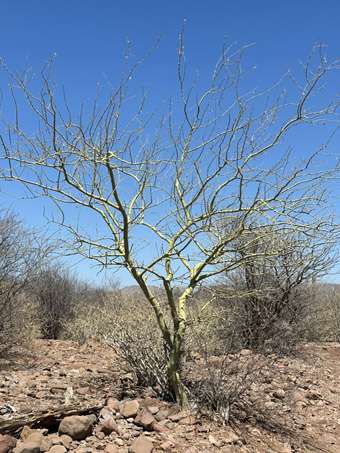
The umbrella-like architecture of Palo Brea, showing the slender trunk and open branching.
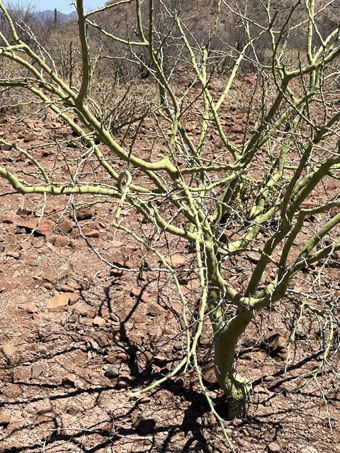
This individual was hardly 2 m tall but 3 m W and shows the typical (mostly) ascending, contorted limbs.
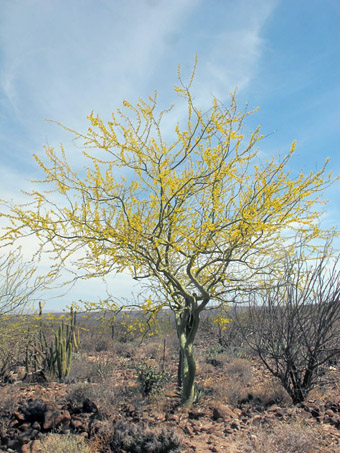
This has to be my favorite Palo Brea tree. Each spring on our way north we are often treated to its exuberant display that glows like a beacon against the darker volcanic backdrop.
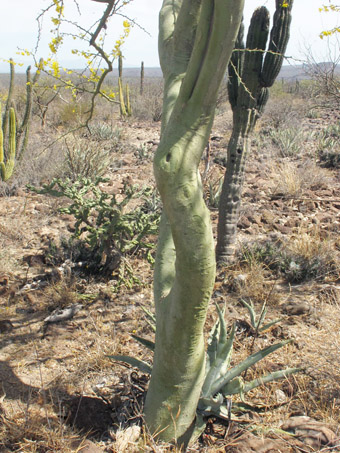
My favorite tree is located near San Ignacio where it sits apart from other Palo Brea in its immediate area. Zooming in, you can clearly see that the trunk is green to the base.
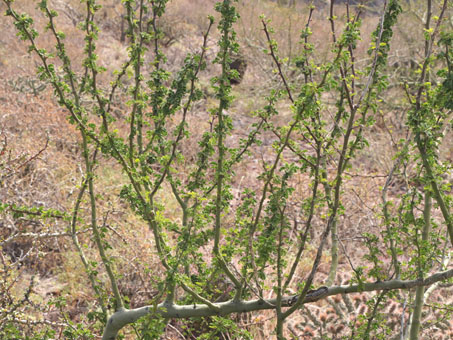
The leaves can create a dense investiture on the long, slender branches.
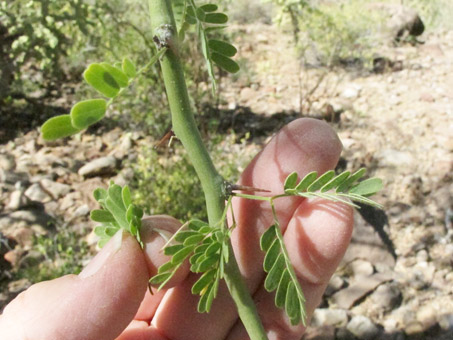
Leaves reach about 3.5-4.5 cm L and have 1-2 pairs of pinnae, each with 4-8 pairs of elliptic to oblong leaflets each 2-10 mm L.
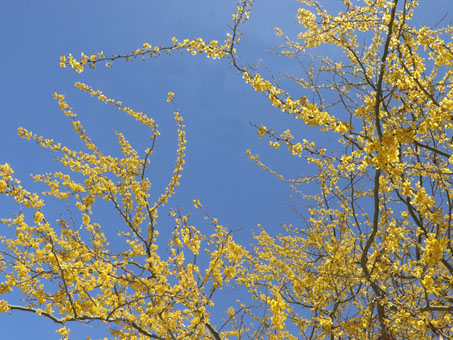
Having shed its leaves, my favorite Palo Brea is now full of bright yellow flowers, densely arranged along the branch on short peduncles.
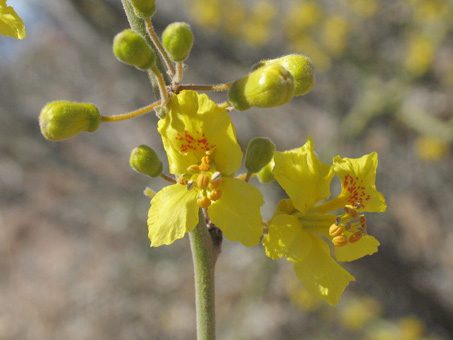
The 1.5-2 cm D flowers have four petals c. 8-12 mm L. The larger banner has a long claw and orange spots near its base.

The spots on the banner fade after pollination. The banner's base color may fade to faintly show some white.
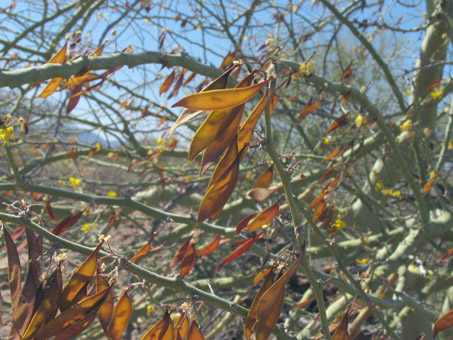
The flat, oblong pods are c. 5-8 cm L and not constricted between seeds.
Parkinsonia xsonorae — Hybrid Palo Verde, Palo Estribo
When I saw one of these trees for the first time from a far (photo below at left), I knew I was seeing a tree that I hadn´t yet seen in the Mulegé area. The mid and lower branches looked a like P. florida, but the profile of the upper crown looked like P. microphylla.
The tree actually turned out to be the somewhat rare, naturally occuring cross between P. praecox and P. microphylla found where the two species grow together. It shows a mix of some of the typical characteristics of each of the parent species.
For example, like P. microphylla, the branches are spinose and are described as lacking nodal spines, although many of the herbarium specimens I looked at on-line actually have 1-3 mm L spines, as did several trees I recently found. The leaves are evenly 2-pinnate with 1-several leaves per node. However, unlike in P. microphylla, which has mostly glabrous herbage and minute leaflets 1-3.5 mm L, P. xsonorae has strigose to lanate herbage and leaflets 4-7 mm L. The flowers are similar to P. microphylla with a mostly white banner. Like P. praecox, the fruit are ovate, thin, compressed and not constricted between the seeds (not moniliform).
While finishing up this entry not long ago, I happened to make a trip to Loreto and had the opportunity to check out a number of the abundant Palo Brea that are visible along a particular stretch of highway between about Km markers 43 and 50. I was happy to discover that within a few meters of a P. praecox and a bunch of P. microphylla there was a hybrid. And there was another across the highway also mixed in with the parent species. Until then, having only seen a few individuals, I had never seen one with what I would consider drooping branches, one of the characters for its identification. But these individuals, along with another I saw later in the day right outside of Mulegé (a big surprise since I´ve passed that spot hundreds of times without noticing it) clearly had drooping branches. All also had whitish banners as well as very small nodal spines on some or most branches.
Range: on the peninsula in BCS near San Ignacio, Mulegé and in the Sierra de Giganta; also Isla Carmen and Sonora.

This leafy, blooming individual is from Mulegé.
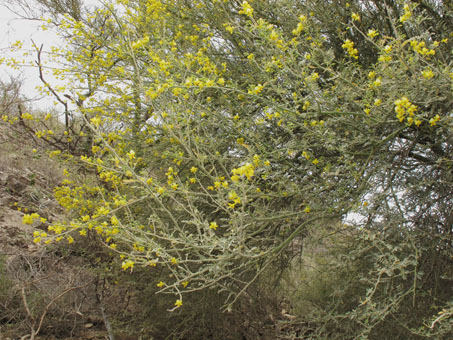
Closer image of the tree at left.
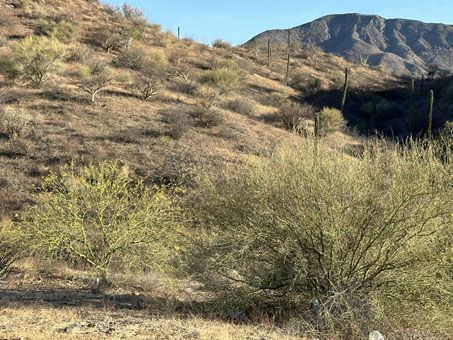
Another Mulegé individual recently found. The hybrid is on the left, P. microphylla is on the right.
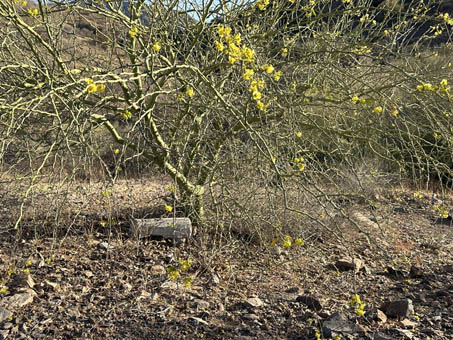
The trunk looks very much like Palo Brea, but instead of an umbrella-like outline, many of the branches at middle and below bend downward.
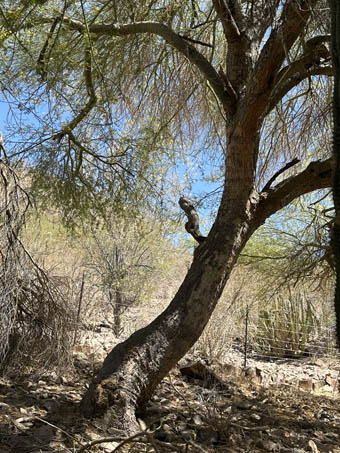
This individual in San José de Magdalena must have been 6-7 m H. The gray bark went all the way up the trunk and along the lowest branches.

The branches formed a low, dense, interwoven canopy full of flowers and some young fruit.

Hybrid leaf on left (4-7 mm L), P. microphylla on right (1-4.5 mm L).
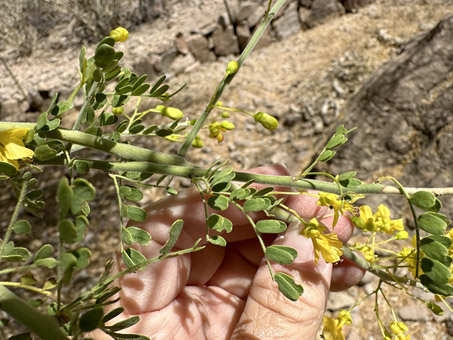
Sessile, 2-pinnate leaves. This tree didn't have spines.
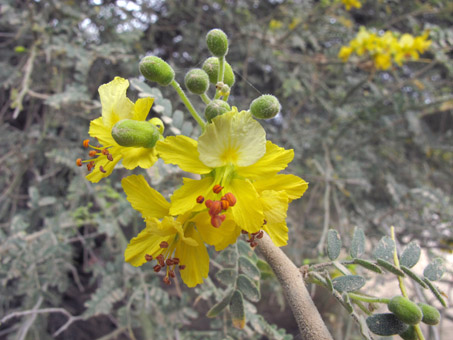
The banner is whitish with tiny, faint orange spots near the claw.
Olneya tesota — Desert Ironwood, Palo Fierro
Desert Ironwood is a common, widespread native shrub or tree. It´s wood is very dense and hard. Because of overharvesting it is now a protected species across the country, though it is abundant on the peninsula. It may reach a height of 10 m, though smaller shrubs and trees are more common.
The green to gray-green leaves are even 1-pinnate, with one or more leaves per axil, 3-10 cm L with 4-12 pairs of leaflets each 5-20 mm L (leaflets on any given leaf are not uniform, with long and short mixed).
Flowers are papilionoid on 2-6 cm L axillary racemes. The calyx is burgundy and densely pubescent. The corolla has purple wings and keel, tinged with yellow. The banner is white to pale pink tinged with yellow and purple. Fruit is a densely glandular-pubescent pod 3-6 cm L x 8-9 mm thick.
Range: desert areas the length of the peninsula from ne BC to the Cape; several Gulf islands; sw US, Sonora.
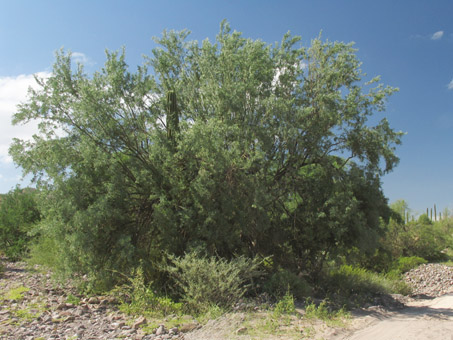
With a lot of moisture, such as here after a tropical storm, the leaves are very green. Under drier conditions, they are gray-green.
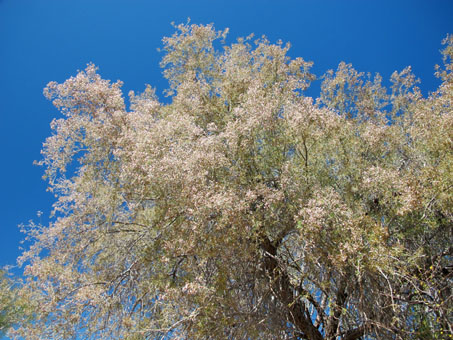
The same tree in bloom. When enough flowers are fully open and waning, the tree takes on a more whitish-gray appearance.
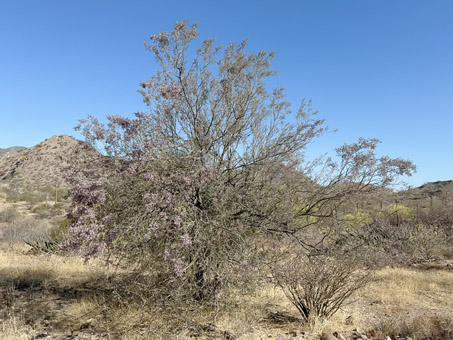
This small tree is just beginning to bloom. The darker purple it appears, the more the burgundy calyces are evident & the flowers not yet open.
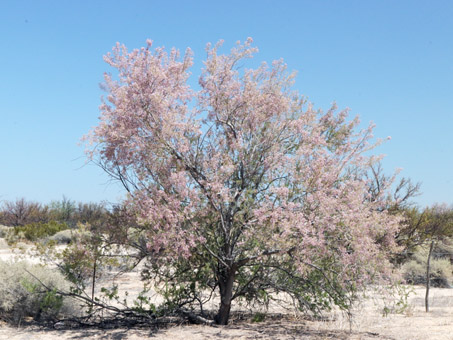
The tree becomes pinker the more flowers there are and the more fully open they are.
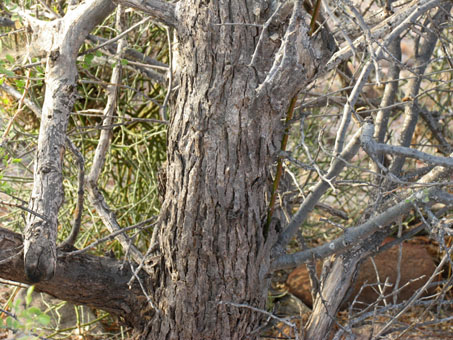
The older bark is gray-brown, furrowed and shreddy.
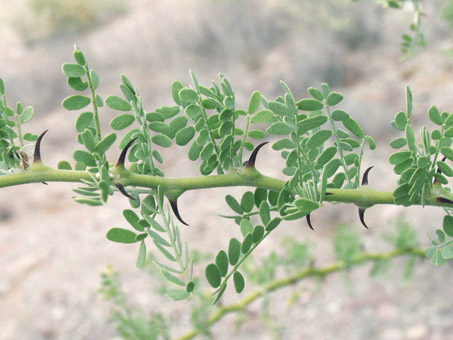
Pinnate Leaves and the black-tipped recurved spines, the origin of one of the common Spanish names: Uña de gato (=cat's claw).
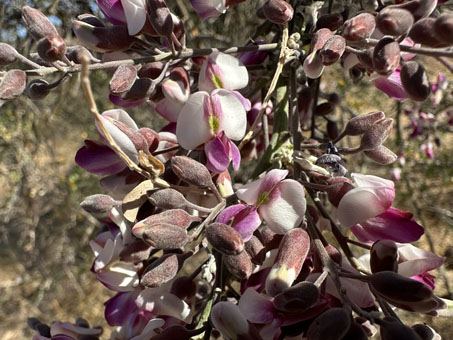
Closeup of the buds (burgundy) and the 9-10 mm L open flowers (pink, purple, white & yellow).
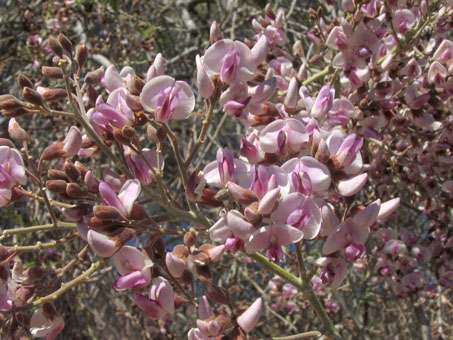
More buds and open flowers, these more pink tinged rather than white.
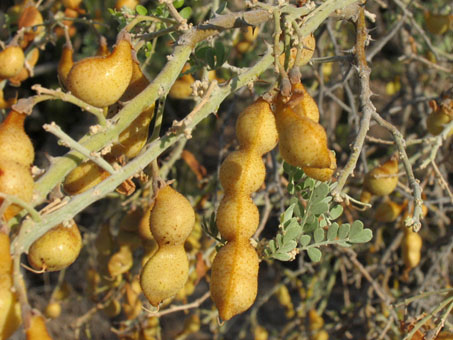
Desert Ironwood pods are about 3-6 cm L, 8-9 mm D, and mostly constricted between seeds. The pod is hairy and glandular.
That's it for this month´s entry and for our time in Baja California. By the time you read this, we'll be on our way back to the US. But who knows what great things we may find on the way north? Until next time, hasta pronto...see you soon.
Debra Valov — Curatorial Volunteer
References and Literature Cited
Rebman, J. P., J. Gibson, and K. Rich, 2016. Annotated checklist of the vascular plants of Baja California, Mexico. Proceedings of the San Diego Society of Natural History, No. 45, 15 November 2016. San Diego Natural History Museum, San Diego, CA. Full text available online.
Rebman, J. P and Roberts, N. C. (2012). Baja California Plant Field Guide. San Diego, CA: Sunbelt Publications. Descriptions and distribution.
SEINet Portal Network. 2024. Olneya tesota. https://swbiodiversity.org/seinet/taxa/index.php?taxon=1410, accessed May 12, 2034
Southwest Desert Flora. Parkinsonia florida. Accessed May 11, 2024.
Wojciechowski, M.F. (2012). Parkinsonia aculeata, in Jepson Flora Project (eds.) Jepson eFlora,
https://ucjeps.berkeley.edu/eflora/eflora_display.php?tid=36267, accessed May 12, 2024.
Wojciechowski, M.F. (2012), Parkinsonia florida, in Jepson Flora Project (eds.) Jepson eFlora,
https://ucjeps.berkeley.edu/eflora/eflora_display.php?tid=36268, accessed May 12, 2024.
Wojciechowski, M.F. (2012), Parkinsonia microphylla, in Jepson Flora Project (eds.) Jepson eFlora,
https://ucjeps.berkeley.edu/eflora/eflora_display.php?tid=36269, accessed May 12, 2024.
Valov, D. (2020). An Annotated Checklist of the Vascular Plants of Mulegé, Baja California, Mexico. Madroño 67(3), 115-160, (23 December 2020). https://doi.org/10.3120/0024-9637-67.3.115
Wiggins, I. L. (1980). The Flora of Baja California. Stanford University Press. Keys and descriptions.




















































